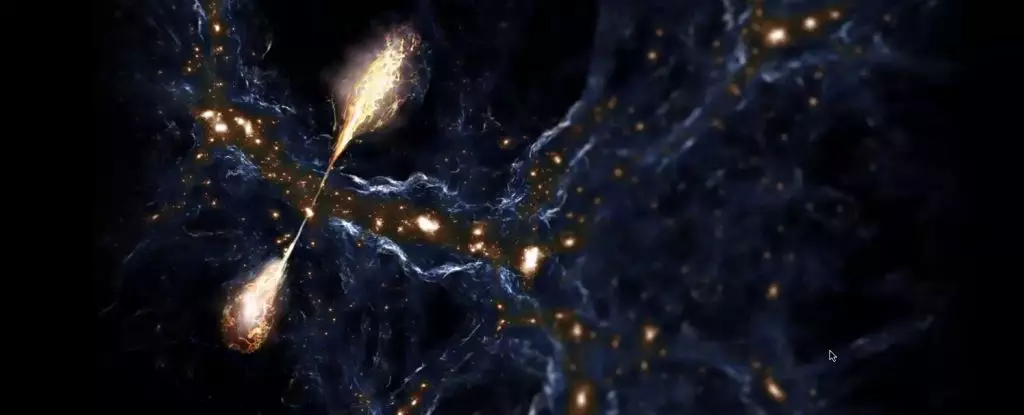

The cosmos continues to astonish us with its intricate structures and phenomena, none more spectacular than the recent discovery surrounding supermassive black holes and their colossal jets. Researchers have identified a particularly striking example known as Porphyrion—a structure so vast that it stretches across an astonishing 7 megaparsecs, or roughly 23 million light-years. This discovery not only adds another layer of complexity to our understanding of the Universe but also raises compelling questions about the mechanics behind such massive formations.
Porphyrion, named after a figure from Greek mythology, exemplifies how individual celestial entities can shape vast cosmic structures. According to Martijn Oei from Leiden University and Caltech, it represents an intimate connection between minuscule black hole proportions and the grandeur of cosmic architecture. To illustrate, if we were to scale down the black hole to an amoeba’s size, the resulting jet emissions would resemble a fountain of energy that envelopes an entire planet. This startling analogy serves as a testament to the extraordinary influence that black holes exert on their surroundings.
However, the significance of Porphyrion doesn’t stop at sheer size. Following the discovery of another colossal jet-producing galaxy, Alcyoneus, it appears that these immense jets may not be isolated phenomena. Rather, they suggest that the conditions and mechanisms enabling such large-scale jet formation might be more commonplace in the Universe than previously thought.
Astrophysical jets form as matter spirals into a black hole, creating a dynamic and turbulent environment known as an accretion disk. Not all the material is consumed, however; some of it is funneled along magnetic field lines towards the poles of the black hole. This process leads to the ejection of jets that can travel at speeds approaching that of light. Despite these understood processes, the sheer magnitude of what we’ve observed with Porphyrion and Alcyoneus presents scientific challenges that require deeper investigation.
To produce jets on such an unprecedented scale, black holes must engage in a continuous period of feeding for billions of years and have access to vast reserves of matter. This continuous feed is atypical for black holes, making the existence of both Porphyrion and Alcyoneus a subject of intense study. Equally puzzling is the stability of these jets over such extensive distances through space-time—a notion that contradicts our current understanding of jet dynamics.
The complexities surrounding the formation and longevity of these jets lead to an array of questions. Current scientific models hint at the instability of jets over time; small perturbations should lead to their destruction rather than their persistence. The presence of Porphyrion’s colossal jets forces researchers to consider factors that might stabilize them against such disturbances.
The discovery of jets extending over such vast distances may carve new paths for research into the structure of the Universe itself, notably the cosmic web. This web consists of filaments that connect galaxies and clusters, often aligning with dark matter’s tangential influence. Porphyrion’s jets, extending up to 66% of the radius of the void, may offer clues into this structuring process, as they potentially influence the thermal properties and magnetic fields of these cosmic regions.
What adds an additional layer of intrigue is the possibility that such intense jet activity was common in the early Universe. The characteristics of Porphyrion resemble those of a radiative mode active black hole— a type thought to be abundant in the formative years of cosmic history. This raises the prospect that the early Universe may have hosted many more colossal jets than current observations suggest, significantly contributing to the development of cosmic infrastructure.
In this light, Porphyrion and its counterparts may help reshape not only our understanding of black holes but also our comprehension of cosmic evolution. As telescopic and observational technology continues to evolve, scientists believe there exists a wealth of undiscovered jet-producing galaxies, waiting to be revealed.
The discoveries surrounding Porphyrion invite us to reconsider the narratives we weave around black holes and their cosmic effects. As our observational capabilities improve, the revelation of even more galaxies linked to vast jets could significantly enrich our understanding of the Universe’s architecture. Indeed, as Martijn Oei aptly notes, the surprising frequency of these massive jet systems remains largely undiscovered—a tantalizing prospect for future exploration. The cosmos holds more secrets than we can currently fathom, and the journey to understand them is just beginning.
In the world of pharmaceuticals, innovation often hinges on finding new compounds that can lead…
In the heart of the Amazon basin, drastic climate changes present an alarming reality that…
Air fryers have rapidly surged in popularity, captivating home cooks and culinary enthusiasts alike. When…
In an era where technology and social media reign, the importance of sleep often takes…
In an era where environmental consciousness is paramount, the maritime industry has long been scrutinized…
Radionuclides, often relegated to discussions surrounding nuclear energy and radioactive waste, have far-ranging implications for…
This website uses cookies.